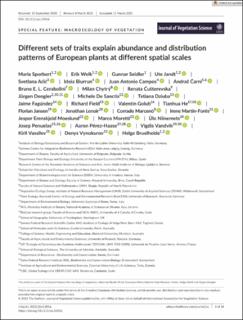Bitte benutzen Sie diese Kennung, um auf die Ressource zu verweisen:
https://doi.org/10.21256/zhaw-22401| Publikationstyp: | Beitrag in wissenschaftlicher Zeitschrift |
| Art der Begutachtung: | Peer review (Publikation) |
| Titel: | Different sets of traits explain abundance and distribution patterns of European plants at different spatial scales |
| Autor/-in: | Sporbert, Maria Welk, Erik Seidler, Gunnar Jandt, Ute Aćić, Svetlana Biurrun, Idoia Campos, Juan Antonio Čarni, Andraž Cerabolini, Bruno E. L. Chytrý, Milan Ćušterevska, Renata Dengler, Jürgen De Sanctis, Michele Dziuba, Tetiana Fagúndez, Jaime Field, Richard Golub, Valentin He, Tianhua Jansen, Florian Lenoir, Jonathan Marcenò, Corrado Martín‐Forés, Irene Moeslund, Jesper Erenskjold Moretti, Marco Niinemets, Ülo Penuelas, Josep Pérez‐Haase, Aaron Vandvik, Vigdis Vassilev, Kiril Vynokurov, Denys Bruelheide, Helge |
| et. al: | No |
| DOI: | 10.1111/jvs.13016 10.21256/zhaw-22401 |
| Erschienen in: | Journal of Vegetation Science |
| Band(Heft): | 32 |
| Heft: | 2 |
| Seite(n): | e13016 |
| Erscheinungsdatum: | 29-Apr-2021 |
| Verlag / Hrsg. Institution: | Wiley |
| ISSN: | 1100-9233 1654-1103 |
| Sprache: | Englisch |
| Fachgebiet (DDC): | 580: Pflanzen (Botanik) |
| Zusammenfassung: | Aim: Plant functional traits summarize the main variability in plant form and function across taxa and biomes. We assess whether geographic range size, climatic niche size, and local abundance of plants can be predicted by sets of traits (trait syndromes) or are driven by single traits. Location: Eurasia. Methods: Species distribution maps were extracted from the Chorological Database Halle to derive information on the geographic range size and climatic niche size for 456 herbaceous, dwarf shrub and shrub species. We estimated local species abundances based on 740,113 vegetation plots from the European Vegetation Archive, where abundances were available as plant species cover per plot. We compiled a complete species-by-trait matrix of 20 plant functional traits from trait databases (TRY, BiolFlor and CLO-PLA). The relationships of species’ geographic range size, climatic niche size and local abundance with single traits and trait syndromes were tested with multiple linear regression models. Results: Generally, traits were more strongly related to local abundances than to broad-scale species distribution patterns in geographic and climatic space (range and niche size), but both were better predicted by trait combinations than by single traits. Local abundance increased with leaf area and specific leaf area (SLA). Geographic range size and climatic niche size both increased with SLA. While range size increased with plant height, niche size decreased with leaf carbon content. Conclusion: Functional traits matter for species’ abundance and distribution at both local and broad geographic scale. Local abundances are associated with different combinations of traits as compared to broad-scale distributions, pointing to filtering by different environmental and ecological factors acting at distinct spatial scales. However, traits related to the leaf economics spectrum were important for species’ abundance and occurrence at both spatial scales. This finding emphasizes the general importance of resource acquisition strategies for the abundance and distribution of herbaceous, dwarf shrub and shrub species. |
| URI: | https://digitalcollection.zhaw.ch/handle/11475/22401 |
| Volltext Version: | Publizierte Version |
| Lizenz (gemäss Verlagsvertrag): | CC BY 4.0: Namensnennung 4.0 International |
| Departement: | Life Sciences und Facility Management |
| Organisationseinheit: | Institut für Umwelt und Natürliche Ressourcen (IUNR) |
| Enthalten in den Sammlungen: | Publikationen Life Sciences und Facility Management |
Dateien zu dieser Ressource:
| Datei | Beschreibung | Größe | Format | |
|---|---|---|---|---|
| 2021_Sporbert-etal_Abundance-distribution-European-plants_JVS.pdf | 2.15 MB | Adobe PDF |  Öffnen/Anzeigen |
Zur Langanzeige
Sporbert, M., Welk, E., Seidler, G., Jandt, U., Aćić, S., Biurrun, I., Campos, J. A., Čarni, A., Cerabolini, B. E. L., Chytrý, M., Ćušterevska, R., Dengler, J., De Sanctis, M., Dziuba, T., Fagúndez, J., Field, R., Golub, V., He, T., Jansen, F., et al. (2021). Different sets of traits explain abundance and distribution patterns of European plants at different spatial scales. Journal of Vegetation Science, 32(2), e13016. https://doi.org/10.1111/jvs.13016
Sporbert, M. et al. (2021) ‘Different sets of traits explain abundance and distribution patterns of European plants at different spatial scales’, Journal of Vegetation Science, 32(2), p. e13016. Available at: https://doi.org/10.1111/jvs.13016.
M. Sporbert et al., “Different sets of traits explain abundance and distribution patterns of European plants at different spatial scales,” Journal of Vegetation Science, vol. 32, no. 2, p. e13016, Apr. 2021, doi: 10.1111/jvs.13016.
SPORBERT, Maria, Erik WELK, Gunnar SEIDLER, Ute JANDT, Svetlana AĆIĆ, Idoia BIURRUN, Juan Antonio CAMPOS, Andraž ČARNI, Bruno E. L. CERABOLINI, Milan CHYTRÝ, Renata ĆUŠTEREVSKA, Jürgen DENGLER, Michele DE SANCTIS, Tetiana DZIUBA, Jaime FAGÚNDEZ, Richard FIELD, Valentin GOLUB, Tianhua HE, Florian JANSEN, Jonathan LENOIR, Corrado MARCENÒ, Irene MARTÍN‐FORÉS, Jesper Erenskjold MOESLUND, Marco MORETTI, Ülo NIINEMETS, Josep PENUELAS, Aaron PÉREZ‐HAASE, Vigdis VANDVIK, Kiril VASSILEV, Denys VYNOKUROV und Helge BRUELHEIDE, 2021. Different sets of traits explain abundance and distribution patterns of European plants at different spatial scales. Journal of Vegetation Science. 29 April 2021. Bd. 32, Nr. 2, S. e13016. DOI 10.1111/jvs.13016
Sporbert, Maria, Erik Welk, Gunnar Seidler, Ute Jandt, Svetlana Aćić, Idoia Biurrun, Juan Antonio Campos, et al. 2021. “Different Sets of Traits Explain Abundance and Distribution Patterns of European Plants at Different Spatial Scales.” Journal of Vegetation Science 32 (2): e13016. https://doi.org/10.1111/jvs.13016.
Sporbert, Maria, et al. “Different Sets of Traits Explain Abundance and Distribution Patterns of European Plants at Different Spatial Scales.” Journal of Vegetation Science, vol. 32, no. 2, Apr. 2021, p. e13016, https://doi.org/10.1111/jvs.13016.
Alle Ressourcen in diesem Repository sind urheberrechtlich geschützt, soweit nicht anderweitig angezeigt.